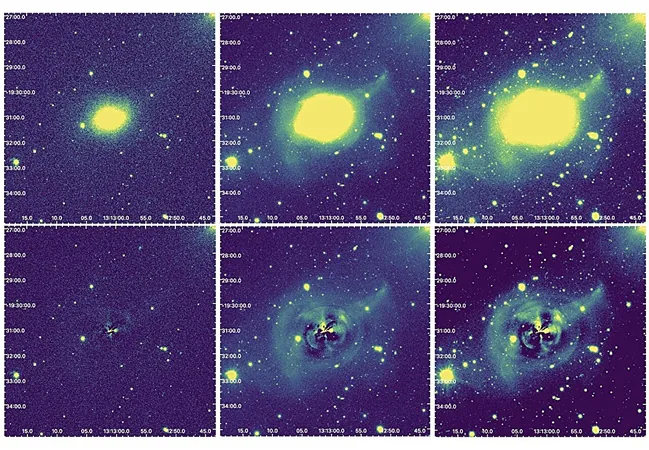
Unveiling Secrets of the Cosmos: Astronomers Reveal the Mysteries of NGC 5018's Globular Clusters!
2025-01-06
Author: Rajesh
Introduction
In a groundbreaking observational campaign, astronomers from Italy and Germany have taken giant leaps in understanding the NGC 5018 galaxy group using the powerful VLT Survey Telescope (VST). The results have been published on the pre-print server arXiv on December 23, showcasing crucial insights into the globular cluster system of this fascinating galactic assembly.
What are Globular Clusters?
Globular clusters (GCs) are more than just mesmerizing clusters of tightly bound stars—they serve as cosmic laboratories that allow astronomers to delve into the evolution of stars and galaxies. These stellar formations are especially important for studying early-type galaxies, as their origins are likely tied to intense epochs of star formation. Understanding globular clusters could unearth vital information about the history and interactions of galaxies within their groups.
The NGC 5018 Galaxy Group
The NGC 5018 galaxy group, located about 132.5 million light years away in the Virgo constellation, is named after its brightest member, the massive elliptical galaxy NGC 5018. Other notable members of this intriguing group include the edge-on spiral NGC 5022, the face-on spiral NGC 5006, and two lenticular galaxies, MCG-03-34-013 and PGC 140148.
Previous Studies
Previous studies have classified the globular clusters within NGC 5018 into two distinct populations: a smaller group of younger globular clusters (ranging from several hundred million to 6 billion years old) and a larger population of older clusters.
The Study by Pratik Lonare and Team
Driven by a quest for further understanding, a team led by Pratik Lonare from the Abruzzo Astronomical Observatory in Teramo, Italy, embarked on a detailed study of the globular cluster system in NGC 5018 and its surrounding group. Their research leveraged the deep, multi-passband imaging capabilities of the VST, which is part of the VST Elliptical Galaxy Survey (VEGAS).
Observations and Discoveries
Utilizing VEGAS data, Lonare’s team identified numerous globular cluster candidates, revealing the presence of an intra-group globular cluster system concentrated around NGC 5018. A striking discovery was made: while NGC 5018 exhibited a notable overdensity of globular clusters, its neighboring galaxies did not show any significant cluster aggregations.
Correlations and Findings
The research uncovered interesting correlations—specifically, the radial density profile of the GC candidates closely mirrored that of the galaxy's surface brightness profile. Furthermore, the color profile analysis revealed two significant components, peaking at about 0.45 mag for the blue GCs and approximately 0.80 mag for the red GCs. Notably, the blue globular clusters appeared to be more dispersed than their red counterparts.
Speculation and Estimates
The authors speculated that this finding may indicate that part of the blue GC population, residing in intra-group space, was originally part of NGC 5018. This could have happened due to tidal interactions with neighboring galaxies, leading to their current distribution.
The Numbers
The astronomers estimate that the total number of globular cluster candidates within the entire NGC 5018 group is around 4,000, while NGC 5018 itself harbors approximately 485 candidates.
Conclusion
As research continues to unfold around NGC 5018, the cosmos keeps revealing its enigmatic beauty and complexity, reminding us of the countless mysteries still waiting to be uncovered in the vast expanse of space. Stay tuned for more astronomical discoveries that promise to shape our understanding of the universe!
 Brasil (PT)
Brasil (PT)
 Canada (EN)
Canada (EN)
 Chile (ES)
Chile (ES)
 Česko (CS)
Česko (CS)
 대한민국 (KO)
대한민국 (KO)
 España (ES)
España (ES)
 France (FR)
France (FR)
 Hong Kong (EN)
Hong Kong (EN)
 Italia (IT)
Italia (IT)
 日本 (JA)
日本 (JA)
 Magyarország (HU)
Magyarország (HU)
 Norge (NO)
Norge (NO)
 Polska (PL)
Polska (PL)
 Schweiz (DE)
Schweiz (DE)
 Singapore (EN)
Singapore (EN)
 Sverige (SV)
Sverige (SV)
 Suomi (FI)
Suomi (FI)
 Türkiye (TR)
Türkiye (TR)
 الإمارات العربية المتحدة (AR)
الإمارات العربية المتحدة (AR)